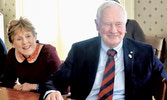Aylmer centre for First Nations explained their innovations to Governor General

David Johnston, Governor General of Canada, and Sharon Johnston were all ears on January 27 as members from the Aylmer-based First Peoples Innovation Centre (FPIC) introduced them to some of their initiatives at the Scott-Fairview House in Hull.
“If I had the opportunity to present the centre in two words, it would be innovation and pride. Everything we do is to support social innovation as thought out by First Nations. Therefore, it is not us who are building and developing the projects in our offices and trying to implant them in the communities. We talk with members of First Nations communities and it is with them that we develop our projects and innovate because our goal at the centre is to do otherwise and to do differently,” said Céline Auclair, Founder and Chief Executive Officer of the not-for-profit Aboriginal organization.
“The other big facet of our organization is pride. Everything we do is to celebrate and to revive cultural pride. This is not to be simply proud of being native, but rather proud of being Innu, Attikamek, Anishinabeg, and to be like everyone who has their own proper identity,” she continued.
One pride restoring project the centre is currently setting up is the Fab Lab. The project is still in gestation, but the concept is solid.
In short, the Fab Lab aims to provide workshops for school dropouts between 15 and 25 who have little on the horizon. “We want to bring those students into workshops where they will find traditional tools, such as a hammer or sculpting tools, but also 21st century tools like 3D printers,” explained Auclair.
The youth who enter the lab explore independently. There are no courses or specific start times. Participants discover and work at their own pace. The idea is that they explore and learn with their peers helping them find a skill or, better yet, a new career path. Ideally, the FPIC will down the road introduce them to training courses.
The approach was developed by the MIT (Massachusetts Institute of Technology) and, according to Auclair, it works well with marginalized youth. The FPIC will do their own evaluation when the project is no longer in gestation. Meanwhile, the Aylmer centre is busy coordinating the Onaki Circle initiative.
This project takes a multi-faceted approach, looking to enhance the cultural identity and engagement of First Nations youth. One component with an environmental angle allows youth to learn about the current and the traditional uses of resources at a local centre. The second is to help youth find a career path, helping them become a positive member of their community. Another facet is the cultural component that teaches youth about singing, dancing, traditional cooking and different crafts.
The idea is to revive some First Nations culture lost over the years.
“Yes, we learn about our culture that has been lost over hundreds of years. We also learn through the program about nature, which is great because the knowledge gets lost over time,” said one student.
With many First Nations students attending Symmes Junior High School and D’Arcy McGee High School, both Aylmer schools and the FPIC work closely together in the project. In fact, close to 10% of the student population is First Nations. Many come from the James Bay Area.
“They come from very far away, to make a better life for themselves,” explained Jennifer Piercey, Aboriginal Success and Spiritual Animator with the Western Quebec School Board (WQSB).
“It’s a difficult transition,” she continued. For many students, it’s their first time in a francophone urban centre.
Coming from a Cree school board, many students are unfamiliar with Ministry of Education’s (MEESR) curriculum. School boards under the MEESR curriculum, in contrast to the Cree School Board, specify that students must learn French and English, unlike Cree schools which teach the Cree language and either French or English.
“Many are used to speaking Cree and English only and learning French for the first time is very challenging,” said Piercey who extolled the youth circle.
“It’s a safe place that allows students to do something when school is out. It also allows them meet other children in the community helping with the transition. Many students are also intergenerational survivors of residential schools and to have a place of healing for them is important.”
The reason many Cree youth end up in Aylmer
schools is because their parents believe their children are getting a better education here and because their parents leave their northern communities to continue post-secondary education here in West Quebec. However, in early February, the tide will change as local students will head north for a stint.
“We received a provincial grant to go north to visit Cree communities. The grant is to raise awareness of First Nations communities,” said Piercey. “We are hoping to bring many non-native students and native students who will act as leaders during the trip.”
Editor’s note: This article was prepared in January 2016.



